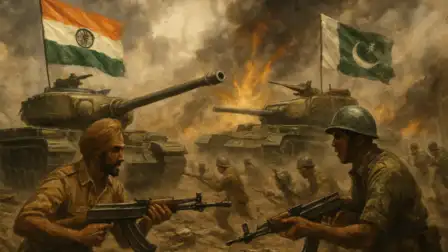Introduction
More than three decades ago, the Central Intelligence Agency (CIA) declassified a chilling National Intelligence Estimate (NIE) that outlined South Asia’s most volatile faultline — the Pakistan-India dynamic. The 1993 report, prepared under CIA analyst Bruce Riedel, warned of an existential fear driving Pakistan’s policy on Kashmir and terrorism. In light of recent attacks like the Pahalgam massacre, this document reads not as history — but prophecy.
1. Pakistan’s Existential Fear of India
The report identified a core psychological driver in Islamabad’s military and foreign policy: a deep, existential fear of India. Pakistan’s fear extended beyond battlefield losses — it was about being dwarfed economically, diplomatically, and globally. India’s steady rise, even amid domestic challenges, contrasted with Pakistan’s political instability and economic woes.
2. Kashmir as the Trigger Point
The 1993 CIA assessment predicted that a conflict between India and Pakistan would most likely begin in Kashmir. Whether through communal violence, militant provocations, or miscalculated military actions, Kashmir was seen as the inevitable spark for a broader confrontation.
3. Proxy Warfare as Pakistan’s Strategy
The document warned that Pakistan might resort to proxy terrorism to counterbalance India’s superiority. Though it did not name groups like The Resistance Front (TRF), it foresaw Pakistan using Islamist militant groups to carry out “low-cost, high-impact” attacks in India under the guise of supporting the “liberation” of Kashmir.
4. Rising Islamism as a Tactical Choice
The CIA posited that Islamism in Pakistan was less about ideology and more about strategy. Facing domestic collapse or political instability, the military might ally with extremist groups to distract the public and provoke India, turning religious fervor into a geopolitical tool.
5. India’s Political Stability Was a Threat
India’s political and economic progress, even under pressure post-Babri Masjid demolition (1992), was seen as a long-term threat by Pakistan. The NIE emphasized that India’s growing economy under PM PV Narasimha Rao and Finance Minister Dr. Manmohan Singh was creating a power gap that Pakistan couldn’t close through conventional means.
6. The US Was Warned: Hotlines Might Fail
Intended as a briefing for the White House under President Bill Clinton, the report cautioned that confidence-building measures like nuclear pacts and military hotlines might prove useless in a real crisis. The risk wasn’t escalation through intention — it was miscalculation, misreading, and blind retaliation.
7. A “Spectacular Terrorist Outrage” Was Foreseen
The report eerily predicted that a major terrorist attack — one side could blame on the other — might become the trigger for conflict. The Pahalgam attack in Baisaran Valley, which killed 26 civilians, echoes this exact scenario, renewing the CIA’s old warning in tragic relevance.
Conclusion
The 1993 CIA document now feels like a grim guidebook to today’s South Asia. It didn’t just predict conflict — it mapped out the psychology, fear, and strategy behind it. As India mourns fresh tragedies and prepares for uncertain confrontations, this declassified report remains a critical lens through which policymakers should reassess the regional equation.
Explore the full timeline of India-Pakistan conflicts and ceasefire violations here.


